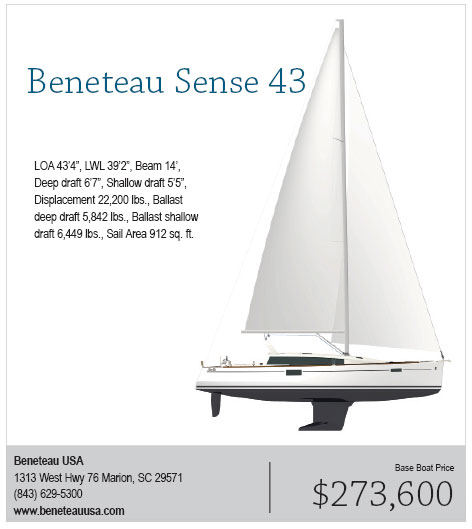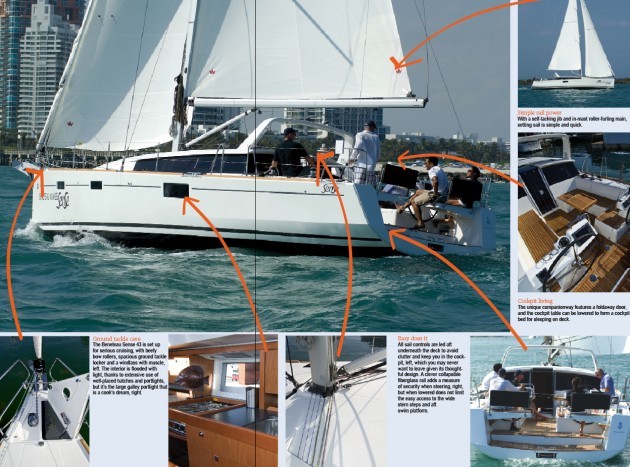Beneteau Sense 43
Sense and Sensibility
Sleek, fast and sensible, this latest midsized cruiser embodies fresh thinking and smart design

The cockpit is designed as much for lounging and entertaining as it is for sailing, and there is a natural synthesis between the cockpit and the cabin. Designers Berret/Racoupeau have created a multihull-like companionway as three sloping, shallow steps deliver you below. There is no sense that you are climbing down a ladder or that the accommodations are buried in the hull. Twin helm stations are located well aft, nearly on the stern, and this maximizes the social area of the cockpit, and maximizes steering efficiency of the twin rudders, especially when sailing on a deep reach. A clever collapsible fiberglass rail adds a measure of security when steering, but when lowered does not limit the easy access to the wide stern steps and aft swim platform. This friendly transom will be welcome in the stern-to world of the Mediterranean, and when boarding from a dinghy.

The offset cockpit table is draped by the starboard bench seats and drops down to form a cockpit "bed." Two large lockers are the result of an interior that is not stuffed with cabins, specifically aft cabins sandwiched below the cockpit. A robust stainless railing offers needed support in the wide cockpit.
All sail controls are led to secondary winches on the aft end of the coachroof. The mainsheet runs to a set of fixed blocks mounted atop an arch that also juts off the aft end of the coachroof. And while this certainly is in keeping with a design that emphasizes keeping human spaces clear of clutter, a traveler would make the mainsail a lot more efficient. The headsail on our test boat was a self-tacking furling jib and the boat was also fitted with a code zero with the sheets led to powered Harken radial winches.
The relatively low-slung hull has a fine entry and a long waterline. Working aft, the hull flairs quickly and holds its ample beam all the way aft, creating a wedge shape that emphasizes livability in the areas where you need it most, the saloon and the cockpit. A hard chine also runs aft from about amidships and serves to flatten the sections and minimize heel. The Sense 43 is designed to be sailed flat, on its lines, and that's part of the appeal to the non-sailing set. The standard draft is 6 feet, 7 inches, but the 5-foot, 5-inch shoal-draft version will be popular on the East Coast. The air draft is an Intracoastal Waterway friendly 61 feet, and sail area, measured with 100% of the fore triangle, is a manageable 912 square feet. The sail area/displacement ratio of 18 and a displacement/length ratio of 135 put the Sense 43 squarely in the moderate category.
The construction is rather conventional with a solid laminate hull and a balsa-cored deck with a typical joint along an inward-facing flange. The keel is cast iron with a bulb and externally fastened to the hull. The workmanship is excellent, the result of efficient scale production and an experienced work force dedicated to getting the details right. The Sense 43 is built at Beneteau's facility in Marion, South Carolina, which has the experience to execute a radical new model without normal startup glitches.
The interior is focused around a remarkable saloon. Designed by the Italian firm Nauta, it emphasizes natural light and ventilation with windows and opening ports facing in all directions, including aft, into the cockpit. The layout feels more like an open apartment than a typical sailboat interior, or maybe more like a cruising catamaran. A large wraparound settee is to starboard with storage above in handsome lockers. The navigation station and desk faces aft, with the compact electrical panel located behind. A well-placed skylight provides even more natural light to this area.
The galley lines the port side of the saloon. This area is lit by a large, low portlight mounted in the hull, which I confess, makes the traditional side of me a bit nervous. Of course motor yachts have had hull ports for years and they offer more light, and more importantly, reduce the closed in feeling. The galley includes a three-burner stove and oven, double sinks and a lot of counter space. There is plenty of storage in overhead lockers and below the counters. An island not only contains extra storage space and a wine locker but also makes a convenient support for leaning against when cooking or simply making your way forward. It also houses a clever foldaway seat for dining at the table, and believe it or not, can be fitted with a lifting flat-screen television. Why not?
The one-head design works perfectly. It is located just forward of the saloon, across from the quarter cabin. It is spacious and naturally includes an enclosed shower stall. The quarter cabin is off to port. The double berth is Pullman style and there is storage in a good-sized hanging locker and in overhead lockers. The forward cabin, or owner's cabin, includes a large double berth, a hanging locker, and terrific ventilation when at anchor with overhead and side opening ports and hatches. The light veneers and white liners keep the boat bright below.
We sailed the Sense 43 on Biscayne Bay and in the Port of Miami. The wind was moderate with an occasional blustery gust, and our route required several quick tacks and jibes. Setting sail was an easy affair as our test boat was fitted with a roller-furling in-mast Selden main in addition to the 100% self-tacking jib. Bearing away on a close reach we sailed at 5 knots in less then 10 knots of true wind. With a bit of gust as we rounded Dodge Island we shot up over 6 knots. The Sense 43 had little tendency to heel, and the helm was very well balanced.
Once we gained a bit of sea room, we rolled in the jib and unveiled the code zero, a tight cut asymmetrical sail that was ideal for our close-quarters maneuvering. We powered up over 7 knots on a reach, and while the helm loaded a bit, it was still easy steering. The twin rudders offered good control. Jibing, we headed back toward the marina on a deep reach and maintained decent speed despite fluky winds. I liked the way the boat handled under sail, it was nimble and relatively fast and very stable.
Backing the boat into the slip I was impressed with how well the Sense 43 handled under power. Unlike the Sense 50, which is equipped with the revolutionary Dock and Go rotating saildrive control system, the 43 is available with just a bow thruster, although that may change. The standard engine is a 56-horsepower Yanmar and there is tankage for 116 gallons of fuel. Access is not the best with the engine located more or less below the cockpit, the only way to reach it is from a small opening behind the companionway steps and through the cockpit lockers, which requires removing everything stored there first.
The Sense 50 was an immediate success and Beneteau has sold out the initial production run. The Sense 43 is following that same pattern and that's heartening for the sailing industry. It is designed to maximize pleasure while on the water; under sail, motoring over a calm sea, at anchor or at the dock. Sailors, who like to pride themselves on putting up with misery, may have to get used to the idea that life aboard can be rather nice indeed. I applaud Beneteau for pushing the sailboat boundaries with the new Sense series. This kind of fresh thinking is just what sailing needs.

Comments